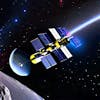S03E31: Guardians of the Galaxy: Space Force's New Era & Earth's Eyes in Orbit

Join Anna on today's celestial edition of Astronomy Daily - The Podcast, where we embark on an interstellar expedition to the frontiers of space innovation and exploration. We begin with the UK's Vertical Future, as they prepare to take agriculture...
Join Anna on today's celestial edition of Astronomy Daily - The Podcast, where we embark on an interstellar expedition to the frontiers of space innovation and exploration. We begin with the UK's Vertical Future, as they prepare to take agriculture into orbit with a £1.5 million grant from the UK Space Agency, aiming to sustain future astronauts with crops grown in space. Then, we navigate the cosmos with the US Space Force, exploring the implications of the Space Based Infrared System's transition for global security. We also examine Inversion's groundbreaking mission with SpaceX, which seeks to establish space as the fourth dimension of transport. Our gaze then shifts to Earth, where the European Space Agency's new Earth Explorer mission concepts promise to unveil the secrets of our home planet. Finally, we discuss the monumental strides SpaceX and Blue Origin are making with NASA's Artemis missions to ensure a lasting human presence on the moon. Fasten your seatbelts, stargazers, as we launch into an episode that not only reaches for the stars but also plants seeds for humanity's cosmic future.
---
**Featured Topics:**
1. **Space Agriculture's New Frontier:** Vertical Future's transformative project to grow food in space, backed by the UK Space Agency.
2. **US Space Force's Infrared Guardianship:** The strategic transition of the SBIRS and its role in missile defense and space situational awareness.
3. **Inversion's Reentry Technology:** Partnering with SpaceX to redefine transportation through space reentry vehicles.
4. **ESA's Earth Explorer Missions:** Four mission concepts set to enhance our understanding of Earth's environment and climate.
5. **SpaceX and Blue Origin's Lunar Logistics:** The collaboration with NASA's Artemis missions to build a sustainable infrastructure on the moon.
---
**Additional Information:**
For more cosmic insights, visit astronomydaily.io, where you can access our full episode archive, stream content at your leisure, and subscribe to our free daily newsletter. Stay at the forefront of space and astronomy news by following us on X (@AstroDailypod), where we connect with space aficionados and share the latest discoveries. This is Astronomy Daily - The Podcast, your trusted source for the latest heavenly news from across the cosmos. Join us next time as Anna guides us through the marvels of the universe. Until then, keep looking up and let's continue to marvel at the wonders of the universe together.
---
**Host Sign-off:** Anna: That concludes today's journey through the cosmic landscape. I'm Anna, and it's been a pleasure guiding you through the latest in space exploration and technology. Remember, the universe is vast and full of potential, so let's keep our eyes on the skies and our hearts filled with curiosity. For more, visit astronomydaily.io, and until our next stellar adventure, clear skies and bold dreams to all our fellow space travelers!
This episode is brought you with the help of NordPass...the password manager that we wouldn't be with out. And we havea great deal for you...just visit www.bitesz.com/nordpass for all the details. You'll be glad you did.
AI Transcript
This podcast explores the latest breakthroughs and missions in space and on Earth
Anna: Welcome to Astronomy daily, the podcast, your daily guide to the cosmos. Today, we're embarking on a stellar journey through the latest breakthroughs and missions that are shaping our understanding of space and fostering advancements across a spectrum of fields. From the pioneering agricultural systems destined for the void of space, designed to perhaps one day feed astronauts on Mars to the critical defense mechanisms ensuring national security. From beyond our atmosphere, we delve into the technologies that are expanding our capabilities in both space and on Earth. Agriculture meets advanced engineering with the UK's vertical future as they gear up to take crop production off planet with the backing of the UK space agency. Then we'll navigate the stars with the United States Space Force, exploring the recent transition of the space based infrared system and what it means for the future of space. Situational awareness and as we consider reentry not just from the edge of space, but into the everyday. We place our sights on Inversion's upcoming mission in collaboration with SpaceX. Their goal? To turn space into the fourth fundamental transport domain. We also gaze down at Earth from above, through the lens of the European Space Agency's new Earth Explorer mission concepts, each holding the potential to unlock secrets of our home planet. Finally, as humanity's gaze turns back to the moon, we'll discuss the work underway on large cargo landers by SpaceX and blue origin, propelling NASA's Artemis missions forward and laying the groundwork for a sustained human presence on the lunar surface. So buckle up, stargazers.
Space agriculture takes root in our extraterrestrial ambitions with NASA grant
Our expedition through the cosmos begins now, right here on astronomy daily. The podcast execute the astronomy Daily podcast the concept of farming stretches far beyond the rich soil of our home planet, as space agriculture takes root in our extraterrestrial ambitions. A forefront runner in this cosmic cultivation is vertical future. They've been entrusted with a 1.5 million pounds grant from the uk space agency in their pivotal second phase of the Autonomous Agriculture for Space exploration project. The goal? To adapt their advanced controlled environment agriculture systems for service aboard axiom, space's first commercial space station. This is groundbreaking. As such technology isn't solely tethered to agricultural purposes. Its versatility extends into realms of pharmaceuticals, nutraceuticals and essential research for space applications. The adaptability and reliability of vertical futures solutions are poised to provide robust capabilities for controlled environment agriculture, ensuring that future astronauts can rely on resilient systems to grow food in the void of space. Leveraging its leadership in both technology and plant sciences, vertical future aligns with the United Kingdom's vision for human habitation, not just in low Earth orbit, but also on farther worlds. And while discussions about living on Mars might sound like the distant future, the implications of these technologies are profoundly grounded in present realities. Fueled by an overarching 20 million pounds international bilateral fund program targeted at commercial space exploration, their work adheres to the Artemis accord's principles, fostering innovation and sustainability. This partnership expands the frontiers of what's possible in space exploration. It's not just about creating a new class of food resources or biomaterials. It's about creating a foundation for sustainable life beyond Earth. With the collaboration of NASA, the Australian Space Agency, and other entities like sabre astronautics, and with academic support from powerhouses such as the RC center of Excellence in Plants for Space and ilaunch, this project aims to establish a fully remotely monitored farm system. This means yielding productivity data not only from our terrestrial outposts, but from those that will float among the stars. Innovation in space technology has historically rippled benefits back to Earth, ranging from the scratch resistant lenses we wear to the cordless tools in our homes. This project, by vertical future, is positioned to extend this legacy, innovation born from the stars that nourishes life back on our own world, addressing challenges such as climatic shifts and geographic limitations afflicting global food production. Space agriculture may still be in its infancy, but with initiatives like these, our ability to support off Earth human settlements is growing by leaps and bounds, promising a more sustainable presence across the solar system. In a pivotal shift for space situational awareness and missile defense, the United States Space Force has achieved a major operational milestone. The guardianship of the space based infrared system, or SBIRS, has transitioned from the space Systems command to the expert hands of the Space operations command. This move is not just a mere change of command it represents a transformative step in bolstering the capability to detect and act upon aerospace threats. From tracking missile launches to offering crucial overhead persistent infrared insights, the SBIRS has served as the nation's vigilant eye in the sky. Under the Space Operations Command's missile warning mission Area team, the system is poised to enhance its role as a linchpin of global space based missile warning. The recent deployment of the SBR 23 one, or the virtualized processing environment release, underscores our ongoing commitment to modernization and resilience in space operations. Viper, as it's aptly named, is the technological evolution of SBIRs, incorporating virtual machines and a Linux based OS to bolster security and system sustainability, all essential in addressing the obsolescence of legacy systems. Let's pause and consider the strategic implications. By integrating cutting edge infrastructure, the SBIRS elevates our readiness to confront the expanding field of aerial threats. It ensures rapid dissemination of vital data, thus nurturing the sinews of national defense and international peacekeeping. Such investments reinforce our strategic posture, ensuring that the space Force continues to maintain its competitive edge as a dominant space power. As global tensions simmer and adversaries seek to challenge our supremacy, it is systems like Viper that will serve as our shield, standing sentinel across the expanse of the cosmos to keep us forewarned and thus forearmed in the ever evolving domain of space exploration. A Ah new chapter is unfolding with Inversion's pioneering reentry technology demonstrator, Ray. This ambitious project is scheduled for launch aboard a SpaceX Falcon nine as part of the transporter twelve rideshare mission, marking a significant leap forward for rapid terrestrial delivery via reentry vehicles. Inversion is a company that originated in 2021 with a vision to revolutionize how we perceive transportation by introducing space as an untethered fourth fundamental domain. The CEO Justin Fiaschetti has emphasized that the first mission of Ray, their technology demonstrator, is pivotal to advancing towards the normalization of space returns, while maintaining a strong focus on cost efficiency. The mission procedure is indeed remarkable. After orbiting Earth, Ray will initiate its descent back to our planet, executing a deorbit burn with its innovative bipropellant rocket engine, and then deploying a parachute system carefully crafted from Inversion's own technology for a controlled splashdown off the coast of California. This meticulous process underlines the extensive in house research and development, underscoring the value of creating a symbiotic relationship between the various subsystems of the capsule and service module. Austin Briggs, CTO of Inversion, illustrated that Ray is merely a prelude to their ambitious next generation vehicles, and is pivotal for validating technologies necessary for their mission's triumph. He envisioned space as a realm without borders, presenting untapped potential for unparalleled transport benefits. Moreover, this mission isn't just a bold statement in space transport, it could catalyze advancements in other sectors by setting the precedent for efficiency and integration of space technologies into everyday logistics solutions. With the successful launch, operation, and return of ray, inversion could well herald a new era where space is not merely a venue for scientific exploration, but also an indispensable layer in our global transport network.
Four innovative mission concepts have taken a leap forward towards ESA Earth explorer satellites
The Astronomy Daily podcast the European Space Agency continues to be at the vanguard of monitoring Earth's delicate systems, and their recent announcement shines a spotlight on the future of Earth observation. Four innovative mission concepts, Cryorad, ISIO, Hydro, Terra plus and Keystone, have taken a leap forward towards potentially joining ESA's estate fleet of Earth explorer satellites. These concepts are a testament to ESA's commitment to piercing the veils of our planet's complex environmental phenomena. Cryorad is focused on peering into the cryosphere, with intentions to advance our grasp on the icy regions of the planet. Anticipated outcomes include a deeper understanding of ice shelf temperatures and sea ice thickness, essential in times where climate change's icy grip becomes more pressing. The eco mission ventures to take a, comprehensive measure of Earth's radiation budget for the first time, providing an unprecedented look into the climate system's energy dynamics. By tracking the balance of incoming and outgoing solar radiation, eco could unravel the complexities of our world's warming patterns. Hydro Terra plus aims at sites from a geostationary perspective, promising to deliver more frequent radar data across swaths of Europe, Africa and the Mediterranean. This would offer us continuous insights into water cycle dynamics and tectonic movements, areas where change could spell both threat and opportunity. Lastly, Keystone's unique approach to m monitor atomic oxygen levels in our upper atmosphere between 50 and 150 km in altitude could illuminate atmospheric processes in ways we haven't seen before. This mission has its fingers on the pulse of variations affected by solar cycles and space weather, adding another layer to our atmospheric understanding. Each of these missions targets vital signs of our living planet and exemplifies the ingenuity driving Issei to decipher Earth's complexities. The four mission concepts now poised for their assessment studies will, over the next 18 months, undergo meticulous scrutiny. Whichever emerges to join the Earth explorer program will undoubtedly push the boundaries of our environmental knowledge even further.
NASA has contracted SpaceX and blue Origin to craft lunar landing systems
In a giant leap for mankind's lunar ambitions, NASA's Artemis campaign stands at the threshold of a new era in space logistics. The agency, along with industry titans SpaceX and Blue Origin, is forging ahead to enable long term exploration of the moon's enigmatic landscape. These endeavors are crucial. NASA has contracted both SpaceX and blue Origin to craft landing systems that will ferry astronauts from lunar orbit down to the moon's terrain. Beginning with the ambitious Artemis III mission. They're not stopping there. These aerospace leaders are now tasked with engineering cargo variants of their human landers. The anticipated cargo versions are designed to deliver significant payloads, specifically targeting between 26,030 3000 pounds. That's about twelve to 15 metric tons of vital equipment, housing units, and scientific instruments straight to the lunar doorstep. In service no earlier than Artemis seven, this development marks a decisive stride towards sustainable lunar exploration. It's essential that NASA has the capability to land not just astronauts, but large pieces of equipment such as pressurized rovers on the moon for maximum return on science and exploration activities, remarked Lisa Watson Morgan, the human landing system program manager. This strategic initiative will ensure that the cornerstone of NASA's lunar expeditions, from bulwarks like the SLS rocket ground systems, Orion spacecraft to the next gen spacesuits, and all the way to the lunar space station gateway, is robustly supplied and supported. Thus begins a new chapter in human space flight, one where the cargo capabilities of SpaceX and blue origins landers will echo the Apollo era's legacy and herald a sustainable future of cosmic discovery and terrestrial benefit. And as we press forward, NASA continues to catalyze international cooperation, leveraging the prowess of space agencies, private industry, and academia to uncover the moon's mysteries. With Artemis, we're not just leaving footprints on lunar soil. We're building footsteps that lead to the red planet and beyond. Stay tuned as we continue to journey through the cosmos, witnessing human innovation touch the stars, and foster a civilization that transcends Earth.
Anna urges listeners to head over to astronomydaily IO for additional space updates
Thank you for joining us on Astronomy Daily, the podcast as we come to the conclusion of today's episode, I'd like to remind our valued listeners to head over to astronomydaily IO for a wealth of additional space updates. Whether you're keen to dive deeper into the topics we've discussed today or you're eager to explore other cosmic content, our website is your go to resource at astronomydaily IO. You'll find an archive of all our past episodes ready to be streamed at your convenience. Packed with insights and discoveries, they're a perfect way to keep your mind orbiting the realms of space, science and astronomy. While you're there, don't forget to sign up for our, free daily newsletter. It's your personal briefing on the latest space space news, delivered straight to your inbox, ensuring that you stay informed and engaged with the ever expanding universe of astronomical knowledge. Lastly, we understand the importance of staying connected and updated in the fast paced world of space and astronomy news. That's why we invite you to follow us on X. Formally known as Twitter stroDailypod, it's the perfect platform for real time updates and conversations with fellow space enthusiasts like you. This is astronomy daily, the podcast, your reliable source for the heavenly news from across the cosmos. Until next time, my name is Anna. Keep looking up, and let's continue to marvel at the wonders of the universe together. The astronomy Daily podcast.
New to Astronomy Daily - The Podcast?
Here are some great episodes to start with.














